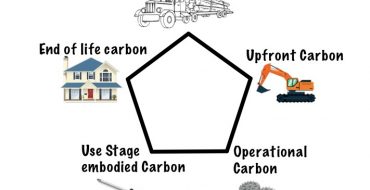
Decoding carbon - Understanding Carbon over a building’s life cycle
By Abigail Knopps
Why is it important to understand the carbon footprint of buildings?
The reduction of greenhouse gas emissions on a global scale is important to slow the effects of climate change. While greenhouse gases have kept the earth livable for both plants and animals for thousands of years, the burning of fossil fuels since the industrial revolution has altered the natural balance of the gases1. As a result, when released in large amounts (as we are seeing today) greenhouse gases such as carbon dioxide and methane stay within the Earth’s atmosphere trapping heat leading to drastic environmental and public health effects – from rising sea levels to increased levels of air pollution.
From groundbreaking to demolition, the life cycle of buildings accounts for 40% of global carbon emissions. This includes everything from the extraction of materials and transportation to energy consumption and replacement of materials2.
What are the different stages of carbon in a building?
Upfront Carbon
Carbon emitted during the production of materials and construction of the building before it begins operation3.
Operational carbon
Refers to the carbon emitted while the building is in use3 (heating/cooling, energy usage, etc.).
Use stage embodied carbon
Carbon emissions associated with materials and processes used during the refurbishment of buildings3.
End of life carbon
Carbon emitted during the demolition and deconstruction of buildings. End of life carbon also accounts for the processing of materials for reuse, recycling, or final disposal3.
Embodied carbon
Refers to the total carbon footprint of all building materials required to produce the building3.
How to reduce carbon emissions throughout a buildings life cycle
- Aim to reuse and refurbish buildings rather than constructing a new one
- Aim to use building materials that are low in embodied carbon or materials that sequester carbon such as sheep wool or bamboo
- Reuse materials whenever possible to eliminate emissions associated with the production of new materials
- Source building materials from regional or local businesses
- Establish carbon targets for the building and operation to ensure emissions are reduced
- Understand where your building materials are sourced from and the carbon footprint associated with them
- Choose durable materials able to endure the lifespan of the building
Examples of companies that have made commitments to reduce carbon emissions
Ford
In Ford’s 2020 sustainability report Executive Chairman William Clay Ford Jr and Jim Hackett, President and CEO said “To protect our planet, both now and for future generations, we are aiming to source 100 percent renewable energy for all our manufacturing sites by 2035. We have also set a new goal for ourselves: achieve carbon neutrality globally by 2050”4.
Patagonia
Patagonia’s mission statement is to “build the best product, cause no unnecessary harm, use business to inspire and implement solutions to the environmental crisis”. Over the past 40 years, they have not shied away from environmental activism. Working with grassroots organizations and activists, Patagonia seeks to take action on the most pressing climate issues in the world5.
In their path towards carbon neutrality, Patagonia seeks to be transparent about all they do. Nearly 70% of their products are made from recycled materials with a goal of using 100% renewable or recycled materials by 20356.
Home Depot
Home Depot has created numerous targets for reducing the effects of climate change. From water conservation measures to public health protections, Home Depot’s motto is “committing to action, delivering results”. Since implementing these climate efforts, Home Depot has seen reduced in-store energy usage by 23.5% since 2018 and is 99% complete with reducing chemicals of concern in cleaning chemicals which is expected to be completed by December of 20227. Together, these efforts will aim for a 50.4% reduction in carbon emissions by 20357.
Citations:
[1] https://www.epa.gov/report-environment/greenhouse-gases
[2] https://www.oneclicklca.com/analyze-life-cycle-carbon-footprint-wooden-buildings/
[3] https://www.worldgbc.org/sites/default/files/WorldGBC_Bringing_Embodied_Carbon_Upfront.pdf
[4] https://corporate.ford.com/microsites/sustainability-report-2020/assets/files/sr20.pdf
[5] https://www.patagonia.com/actionworks/about/
[6] https://www.patagonia.com/why-recycled/
[7] https://corporate.homedepot.com/responsibility/performance